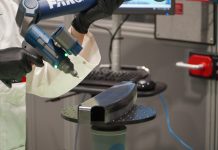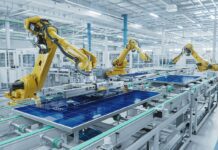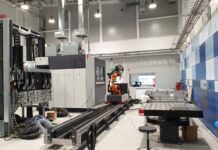Sponsored Content by
Part 4: Building intelligent applications
Intelligent applications are artificial, intelligence-enabled applications that interact with and support the Industrial Internet of Things (IIoT) – physical objects with sensors, processing ability, software, and other technologies that connect and exchange data with other devices and systems.
In a manufacturing setting, artificial intelligence and machine learning (AI/ML) offer high-quality automation and predictive intelligence capabilities. An important part of a smart factory transformation, AI/ML are accompanied by digital technology, real-time data-driven systems, cloud computing and analytics, and automation.
“To start delivering strategic value and capability and realise the full value of Industry 4.0’s new cloud-based data fabric, intelligent applications that incorporate chatbot services, natural language processing, machine vision, recommendation engines, predictive maintenance and even actions can be deployed,” says Simith Nambiar, Practice Lead – Emerging Technologies at Rackspace Technology.
Here’s how to begin building intelligent applications for your smart factory transformation:
Analyse your operational pillars
Before embarking on an AI/ML and intelligent application-focused journey, it’s worth taking the time to objectively analyse three operational pillars: your business drivers, your capacity and preparedness for organisational change and your approach to technological transformation.
This will enable you to develop an in-depth understanding of your goals and current capability, and any knowledge or practice gaps. You can then responsively design and build a custom, future-proof Industrial Internet-of-Things (IIoT) infrastructure to start meeting your goals, filling any gaps, and working within or strategically stretching your capability.
As a starting point, your IIoT infrastructure will likely include features like continuous monitoring of factory floor equipment and machine learning predictions for processes.
Design and build for system alignment
Future IIoT platform design and architecture must be designed and built to be aligned with information technology systems and operational technology systems.
“With the help of data, organisations can take their resources further, delivering intelligent applications, services and results, enabling the business to make smarter decisions, improve collaboration, deliver new revenue streams and business, models, and transform customer experiences,” says Nambiar.
Empower your business’ information and operational technology integration to enable use cases in data collection, connection, ingestion and integration. These use cases should be driven by key performance indicators to measure increases in operational efficiency and will help you to track and improve your progress.
Outsource to a trusted partner
Many manufacturers, wary of the complexities of AI/ML and the high risk of implementation failure, are outsourcing this aspect of their smart factory transformation to a trusted partner.
Rackspace Technology understands how important getting it right is to Australian manufacturers.
“We understand that an hour of downtime in a manufacturing or mining plant can translate to millions of dollars lost over a period of time,” says Simith.
“Happily, taking new ideas and turning them into products takes only months as opposed to taking years a decade ago. We are continuously bringing new offerings to market to close the gap so that we can meet the customer at the right place in their digital transformation journey. This involves rapidly building solutions working closely with the sales, technical and marketing teams and taking solutions to market.”
See the previous articles in the series: Part 1: Building the foundation, Part 2: Modernising the data architecture and Part 3: Setting the stage for more innovation.




















